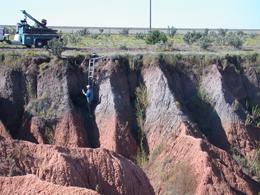
© Vance HollidaySediments at the San Jon site, in eastern New Mexico, contained very low abundances of magnetic spherules said to be evidence of an impact.
An independent study has cast more doubt on a controversial theory that a comet exploded over icy North America nearly 13,000 years ago, wiping out the Clovis people and many of the continent's large animals.
Archaeologists have examined sediments at seven Clovis-age sites across the United States, and did not find enough magnetic cosmic debris to confirm that an extraterrestrial impact happened at that time, says the
report in the
Proceedings of the National Academy of Sciences (PNAS). It is the latest of several studies unable to support aspects of the impact hypothesis.
In 2007, a team led by Californian researchers announced a
theory that a comet or asteroid had exploded over the North American ice sheet, creating widespread fire and an atmospheric soot burst followed by a cooling period known as the Younger Dryas.
Sometime after this, the Clovis people, sophisticated large-animal hunters known for their spear points, mysteriously disappeared; the team linked their vanishing to the environmental effects of the proposed impact.


Comment: For a more in-depth view, read: The Younger Dryas Impact Event and the Cycles of Cosmic Catastrophes - Climate Scientists Awakening